°Arcus°
Home » Creation stories » West Africa
CREATION STORIES FROM WEST AFRICA
AKAN
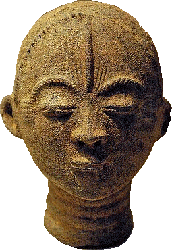
The Akan people are a population group centred upon the modern-day nations of Ghana and the Côte d'Ivoire. Their religion, Akom, knows of a creator deity.
This all-powerful and all-knowing deity - known by various names, including Ɔbɔadeɛ, Anansi Kokuroko, Odomankoma, Brekyirihunuade, Nyame and Nyankopon - formed the universe, but remains aloof from his creation. Some traditions posit a triad of deities or a deity with a triune nature, the names associated with which are Nyame, Nyankopon and Odomankoma.
Ɔbɔadeɛ had a wife, Asase Yaa, the Earth Mother, and the couple had two children, Bia and Tano. Ɔbɔadeɛ also empowers a group of lesser deities whose purpose is to assist humanity. These are known as abosom and are associated with nature.

ASHANTE
The Ashanti are one of the Akan peoples, who enjoyed a powerful kingdom in the region of modern-day Ghana. Their creation account names Nyame or Nyankopon as the creator of the world. Foremost among his creation in the early days of the universe was the spider Ananse, a popular trickster, who was the creator of humanity, as well as the sun, moon, stars, day and night - all of which seems to have been done without Nyame's knowledge.
BAMBARA

For the Bambara of Mali, the chicken and the egg conundrum is somewhat moot.
Early in the history of the universe, the baby chicken and the egg go out to pick lemons. The chick asked the egg to climb a tree, to which the egg replied that it could not. The chick then went itself, shaking loose a number of the fruit, which the pair proceeded to eat. Next, the egg said that it would be able to climb if the chick would spread some dirt beneath the tree to soften its landing should the egg fall. The chick, however, was either careless or - less likely - malicious: it left a pebble in the bed of earth.
Subsequently, the egg shakes the fruit, but inevitably topples, landing on the pebble and meeting its doom. This sets off a strange sequence of events. The chicken, laughing at the egg's predicament, is decapitated by a branch, which is soon destroyed by fire. The fire is extinguished by water, which in turn soaks into the earth. At each turn, the succeeding entity finds its own work at its predecessor's expense hilarious.
Eventually, the earth gets into a dispute with God, the result of which is that God drops the earth into space, where it is now.

DAHOMEY
Dahomey mythology credits Nana Buluku as the Supreme Creator who gave birth to Mawu the moon and Lisa the sun, whereupon she left the cosmos in the care of her children.
DOGON

The famous Dogon of Mali tell an elaborate creation story.
In the beginning, there was a world egg. This was shaken by seven stirrings within the formative universe. This caused its division into two birth sacs, which each contained twins fathered by Amma, the supreme being, upon the maternal egg. The twins - known by the name Nummo - were male and female, but also had the essence of both genders within them. Eventually, one of them, a male by the name of Yorugu, was able to burst forth from the placenta prior to the appointed time. Yorugu took the piece of the placenta and formed the earth. He then went to try to retrieve his twin, but found that she had vanished: she had been transferred to the other egg sac. This led Yorugu to return to the surface of the earth. He copulated with the earth but failed to create life as a result. Witnessing all this taking place, Amma decided to dispatch the other twins down to procreate and it is from this brother, sister and cousin that humans arose.
Also, another myth describes a time when women were able to pick stars from the sky to give to their children. The stars were created when Amma threw pieces of earth into space, before creating the moon and sun by way of pottery. The sun is a pot which is surrounded by red copper, while the moon is surrounded by white. Africans were descended from the sun's light, with Europeans derived from moonlight.
Amma created the world in the same way, by casting a lump of clay into space. The world then took on a female form, with a termite mound for a clitoris and an anthill for a vulva. Amma came to desire this female earth and attempted to penetrate her. At this, the termite mound rose to block his entrance into the anthill. Amma then proceeded to cut down the mound and to have sex with the earth. This, however, disturbed the natural order of things. As a result, his offspring was not twins but a jackal. Again, Amma made love to the earth, filling her with water and eventually bringing forth twins. These took the form of humans with the lower bodies and red eyes of snakes, covered with small green hairs. These were the Nummo. They had Amma's essence and went to visit him above, where he taught them the arts of civilisation. The Nummo dwell in water to this day.
EFIK
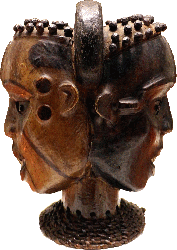
The creator, Abassi, created humans. However, he soon became fearful of their ambitions and hatched a plan to destroy them. Atai, Abassi's wife, however, interceded on the humans' behalf, and Abassi acquiesced, with the caveat that the people were forbidden from procreating, as well as growing or hunting food. In order to keep them alive, the humans were summoned by a bell which called them to Abassi's table in the heavens.
Eventually, the woman started to grow food on earth, which had the effect of making the human race neglect to attend upon Abassi, preferring instead to eat the food grown on earth. Additionally, while working together, the man and woman began to copulate, whereupon children were born to them.
Abassi, despite the best efforts of the children's father, discovered what had taken place, and blamed Atai for having caused him to desist from his original plan. She ought to have recognised the danger this new race presented. This prompted Atai to send down death and discord to earth, which ensured that humanity retained an inferior position vis-à-vis Abassi and Atai.

EKOI
In the beginning, Obassi Osaw and Obassi Nsi created the universe. Obassi Osaw then decided to live in the sky, while Obassi Nsi chose to dwell upon the earth. Thus, Obassi Osaw is the bestower of gifts such as light and rain, as well as storms and drought. Obassi Nsi, meanwhile, nurtures the human population of the earth, giving them food and taking them back to himself upon their deaths. One day, Obassi Osaw created a man and a woman and placed them on earth. Obassi Nsi taught them the arts of agriculture, while Obassi Osaw sent them water from his blue cloak.
FON
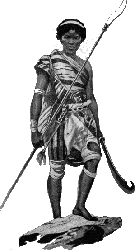
In the beginning, there was the creator. There are varying accounts as to the identity of this deity: -
- Mawu-Lisa, the lunar-solar male-female entity;
- Mawu, the moon goddess; or
- Nana Buluku, an androgynous deity and mother of Mawu and the sun god Lisa.
Nana Buluku is also featured in the religion of the Ewe people, as well as the Igbo and Yoruba, who call her Olisabuluwa and Nana Bukuu respectively. Mawu (and Lisa) subsequently created the earth and all life upon it but, concerned that it might become too heavy, she tasked Aido Hwedo, the primordial "Rainbow Serpent," to carry out the task of raising the earth towards the sky, while asking Awe, a monkey, to fashion more animals from clay. Unfortunately, Awe became puffed up with pride and boasted that he was now equal to Mawu. Another helper of Mawu's was the trickster Legba. The first woman, named Gbadu, saw what was happening and dispatched her children across the earth to remind the people of Mawu and her work, and that only she can confer the breath of life, Sekpoli, upon created entities. Among Gbadu's daughters was Minona, who taught the use of palm kernels as a way to divine Mawu's will. Eventually, Awe sought to climb into the heavens to demonstrate his parity with Mawu. He failed, and Mawu gave him some porridge laced with the seed of death, teaching him that only she can give life - and take it away.
Among Mawu and Lisa's children were the twins Xevioso and Gun, with the former serving as a thunder god. Another son, Agbe, became lord of the seas. However, tidal waves and earthquakes are not his domain: instead, these are explained by a readjustment in position of Aido Hwedo.
FULANI

The Fulani believe that the world was created from a drop of milk. From this primal entity there emerged Doondari, who proceeded to create stone, which itself made iron. Iron then made fire, which created water, which made air.
Thereafter, Doondari came to earth for a second time and created the first man. The man was, however, an arrogant individual, which caused Doondari to strike him blind to humble him. This, however, caused blindness to become proud, so Doondari created sleep. Sleep then became arrogant, so Doondari created worry, which itself needed to be defeated by death.
When death too became powerful and overbearing, Doondari descended for a third time in the form of Gueno, who overcame death.
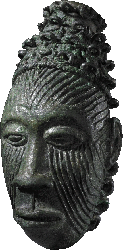
IGBO
Chineke created the cosmos and all life. Other important figures are the sun, Chukwu, and Olisabuluwa.
IJAW

In the beginning, there was a field, within which was a gigantic iroko tree. A table containing a pile of earth descended into the field along with a chair and a creation stone. Soon, Woyengi also descended and sat on the chair, heralded by thunder and lightning. She took the earth from the table and, resting her feet upon the creation stone, made the first humans. Into them, Woyengi breathed the breath of life.
These first people were neither male nor female, so Woyengi told them to choose which gender they would be. This being done, she asked them what mode of life and death they would prefer, thus setting the fates of these people in motion. One of their number, a woman by the name of Ogboinba, asked for sacred powers, while another woman asked for fine children who would live successful lives. These two were then slated to be sisters. In time, Ogboinba and her sister were born in the same village and lived together until the time came for them to marry. However, while her sister was blessed with fecundity, Ogboinba was barren of anything but magic. By this time, she was deeply distressed, and sought Woyengi, to make entreaties for her way of life to be changed. She eventually resorted to force and, for this indiscretion, Woyengi condemned Ogboinba to live forever in the eyes of other people.
KONO
In the beginning, all was dark. Sa - or Death - dwelt in its midst with his wife and daughter. He wanted something more stable, so he used his magical abilities to fashion a slushy sea of mud to live in. Suddenly, Alatangana appeared and visited Sa, expressing his disgust at Sa's lifestyle and claiming that he could do better. It got off to a good start, with Alatangana making the mud more solid and producing animals and plants. Sa himself was pleased, and offered Alatangana his hand in friendship. Alatangana, however, responded by asking or Sa's daughter in marriage. This was refused.
Soon, however, the pair eloped and had children: four white boys and four white girls, as well as three black boys and three black girls. All spoke different languages, so that Alatangana and his wife became upset at not being able to understand them. In order to get some advice, they visited Sa, who was displeased and said that this was his doing. He gave the white children intelligence and writing, while the black children were given tools to feed themselves and find shelter. The black children were, however, not allowed to marry the whites.
The people scattered all over the world, though Sa was again needed to create light, which he did by telling two birds how to sing the requisite songs. Thus, the tou-tou and cock became morning birds.
Sa fixed the sun on its course and bedecked the night sky with moon and stars, before summoning Alatangana to demand, in return for these gifts, tht Alatangana give Sa his children in return for his daughter whenever it is requested.
KRACHI
In the beginning, Wulbari (Heaven) dwelt atop Asase Ya (Earth), with man between them, pressed for room. Man's squirming irritated Wulbari to the point where he moved up above, becoming the sky we know today. Particularly irksome to Wulbari was a certain old woman who was in the habit of striking him with her pestle whilst grinding maize, and another who regularly sliced pieces of him off to flavour her soup, while the smoke from the people's fires kept irritating his eyes. Another bugbear was the habit of men choosing to wipe their dirty hands on him.
Eventually, after he departed for his lofty station, Wulbari dispatched a group of men and a group of women. After meeting, the groups paired off, and their offspring were the Krachi people.
One day, a gigantic bird with a penchant for human flesh appeared, which brought death to the Krachi. Wilbari sent some medicine to a dog, only for the beast to cast it aside to gnaw on abone, whereupon it was picked up by a goat, who was the representative of grass. Thus, grass received the medicine which enables it to grow afresh on a yearly basis, while people simply die at the end of their allotted life spans.
MANDÉ
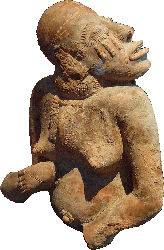
According to the Mandé of southern Mali, the creator Mangala carries out the work of creation by means of the formation of a series of seeds. At first, he makes an abortive attempt to create the balaza seed, followed by two kinds of eleusine seeds, which came to be referred to as "the egg of the world in two twin parts which were to procreate."
Thereafter, Mangala fashioned a further three pairs of seeds, which became the four elements and the four cardinal directions. Mangala then moulded this creation into the form of a hibiscus seed. The twin pairs of seeds, male and female, are the egg/placenta of the world. This hibiscus seed contained within another pair of male and female forms. These included Pemba, who, in his desire to have power over creation, tore out a piece of the placenta and departed the egg before any other being. The placenta he had torn off became the earth, though Pemba found it a world of little promise, causing him to seek to return to the egg.
Mangala, however, had rescued the situation, turning the remaining placenta into the sun, thus leaving Pemba with no hope of rejoining his twin. This led Pemba to steal seeds from Mangala, which he sowed upon the bare surface of the earth. Only one germinated, due to its proximity to the life-giving placental blood which remained. This, however, caused the contamination of the earth due to this placenta being Pemba's.
In order to atone for his sin and purify the nascent planet, Pemba's twin Faro - who had taken the form of two fish - was sacrificed, being cut into sixty pieces which, upon falling to the earth, were transformed into trees. Mangala restored the dead Faro to life and gave him human form, dispatching him to the earth by means of an ark formed from his placenta, along with four other male-female twins who gave rise to the human race, and the various flora and fauna which would populate this new world.
After them came Sourakata, who brought with him the first sacred drum, fashioned from the skull of Faro, which was used to bring rain. Unsuccessful in this endeavour, the first blacksmith came to earth, striking a rock with his hammer, which brought the first refreshing shower.
Faro then ordered the world, using the offspring of Mangala's seeds, causing a flood to arise to wash away all the tarnished work of Pemba. The righteous were saved within Faro's ark.
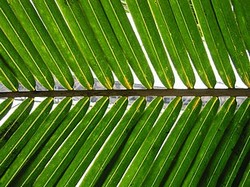
NRI
Eri was a being from the sky realm sent by Chukwu, the source of all life in the universe and orderer of the cosmos, with the aid of lesser deities whose fields of interest are designated by him. The Igbo call the creator Chineke, with Chukwu represented by the sun. Eri reigned as the first king of the Nri Kingdom and he brought divine laws and ordinances to the people of the Anambra region.
NUP

In the beginning, God the creator made tortoises, humans and stones, male and female. They could not, however, reproduce, but, once reaching old age, their youth was renewed. These creatures, however, longed to have children. God, however, cautioned them that, if he were to assent to their requests, then death would come into the world. Of the three forms of life, the tortoises were the only to insist. As a result, death came to the tortoises.
Some time later, and in spite of this turn of events, the humans too decided that they wished to procreate. Again, death was the downside to this being granted. Seeing this, the stones realised that this was not a particularly good course to follow. That is why the stones do not bear offspring and remain alive throughout the aeons when the other life forms are assigned a short life span.
SERER

In the beginning, Roog existed alone within a universe which was silent and dark. This entity proceeded to fashion the cosmic egg, which gave rise to the underworld, the higher world - which included sun, moon and stars - and a middle world which was at first in the form of a swamp, in the midst of a primordial ocean. At this time, the three elements water, air and earth were just coming into being.
Within this quagmire, the first tree grew. There is some disagreement as to the precise species of tree which was the first to arise, with a number of sacred trees appearing in Serer lore: -
- Saas or Sas;
- Nquƭ, Ngud or NGut;
- Somb;
- Nqual, Ngaul or NGawal;
- Mbos.
These trees are associated with a variety of animals which appear on the scene early on, including the ostrich, snake, jackal and hyena. These animals represent the life force inherent within nature.
Humans are the result of the creation of male and female Godparents, with the earliest being revered as Pangool (ancestral spirits).
YORUBA

In the beginning, Olodumare created the cosmos, including the planets. Some time later, truth was sent in order to assess these worlds for habitability. At this point, the earth was deemed to be too wet to support life. As a result of this, several gods, led by Obatala, were dispatched in order to form the earth's crust, allowing life to thrive here. Obatala arrived bearing a mollusc which contained soil, some winged animals and a cloth. These were placed onto the water, forming a large mound, which the winged beasts proceeded to scatter around, thus forming a large area of dry land, featuring hills and valleys.
Obatala ascended to a high point and called it Ife (full name Ife Oodaye, the "Cradle of Existence"). The land soon became fertile and rich in plant life. Meanwhile, Obatala made use of the earth to form figurines, while Olodumare brought gases from the furthest reaches of the universe and caused an explosive reaction, forming a fireball. This he sent to Ife, where it dried much of the land and baked the mannekins made by Obatala. At this point, Olodumare caused the breath of life to blow over the land, which brought these earthen figures to life as the first human inhabitants of Ife.
